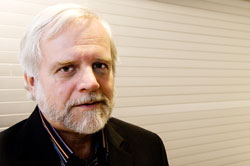On the watch for energy efficiency

Yves Gilbert monitors energy consumption from the number of light bulbs to the way we keep entire buildings warm through the winter.
Rob Maguire
Concordia has held the title of most energy-efficient of the six major Quebec universities for 10 years in a row. Yves Gilbert, Director of Customer Service and Operations Development at Facilities Management, can claim some of the credit for that.
Given that the last decade has seen us open two buildings with numerous labs and workshops using state-of-the-art equipment, just maintaining our current rate of energy efficiency and our number-one status is an achievement.
But Gilbert is not satisfied. He would like to see us use 15 per cent less energy per square metre by the 2009-10 fiscal year.
He has always been passionate about reducing energy use and cutting waste, though those concepts were not always popular. “I didn’t really mention the environment 10 years ago. Now I don’t hesitate to mention the benefits.”
That has meant convincing senior administrators of the long-term profitability of energy efficiency, since more efficient systems usually require a greater initial cost.
Gilbert said most of the changes that Concordia has implemented are simply improvements in traditional practices, not glamorous technology like solar panels or alternative energy sources.
When the heating, lighting and cooling systems operate and how they adapt to occupancy levels are factors that are monitored more closely, with a more responsive infrastructure.
“We used to have heating, cooling and lighting systems that turned off at night and on the weekend. Now, by having more variable controls on our heating and cooling systems, we can shut them when there is no motion in the area,” Gilbert said.
Similarly, offices used to use less efficient fluorescent systems. Now, fewer and more energy efficient tubes are used, and their placement is carefully planned.
Current systems also measure carbon dioxide levels. Instead of pumping in fresh air at fixed percentages (which might need to be heated or cooled, depending on outdoor temperatures), that process is only begun when the air is necessary.
Gilbert said planning is key. “Never miss an opportunity to be at the planning stage of a renovation. Making changes afterwards is so much harder.” Thus, these principles have been built into the renovations on the upper floors of the Hall Building over the last few years.
Of course, new buildings offer the possibility of using more energy-efficient materials and making decisions from the ground up. For the past six years or so, Gilbert has been involved in the planning stages of new buildings. He had input in the design for the Richard J. Renaud Science Complex. He has been actively involved in both the construction of the EV Building and plans for the JMSB building currently going up.
There are still possibilities with older structures.
“The Grey Nuns Building is so much more challenging,” Gilbert acknowledged. The building has not been insulated. Some parts of the building are over a century and a half old. Even the “newest” sections were built over 100 years ago.
“There is concern that insulation will have a deteriorating effect on the masonry. But there are opportunities to improve the heating and cooling systems.”